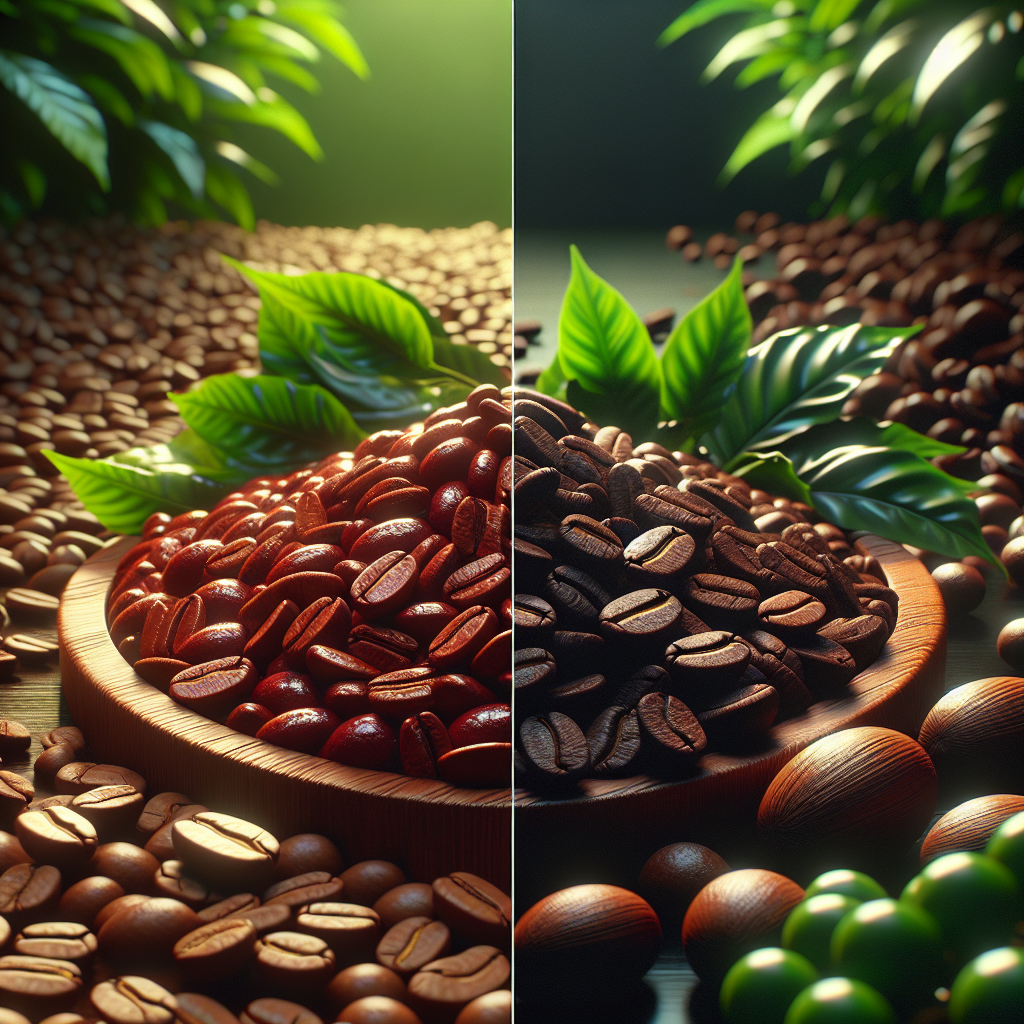“`html
Comprehensive Guide to Understanding the Difference Between Arabica and Robusta Coffee Beans
The debate between Arabica and Robusta coffee beans is long-standing, each offering unique qualities suitable to different preferences. Generally, Arabica is more favored for its sweet and complex flavor profile, while Robusta is renowned for its strong and bold taste. This guide will dive deep into the various elements that distinguish these two popular types of coffee beans.
| Feature | Arabica | Robusta |
|---|---|---|
| Taste | Sweet and soft with notes of sugar, fruit, and berries | Bitter with a fuller body, often harsher and less complex |
| Complexity | Complex flavor profile | Simple and straightforward flavor |
| Finish | Smooth finish | Earthy overtones and nuttiness |
| Best Uses | Specialty blends and high-quality brews | Instant coffee and espresso blends |
1. Flavor Profile of Arabica vs. Robusta
Sweet and Soft Taste: Arabica coffee beans are known for their sweet, soft taste featuring notes of sugar, fruit, and berries.
Bitter and Full Body: Robusta coffee beans typically possess a more bitter flavor with a fuller body.
Complexity: Arabica offers a complex flavor, while Robusta is often seen as harsher and less complex.
Smooth Finish: Arabica beans have a smooth finish, making them preferable for many coffee enthusiasts.
Earthy Overtones: Robusta can have earthy or nutty undertones depending on its growing conditions.
Subtlety in Arabica: Subtle flavor notes in Arabica can appeal to a refined palate.
Robusta Robustness: Strong and robust nature of Robusta is ideal for espresso blends.
Pairing: Arabica is better for specialty blends, whereas Robusta works well in generic instant coffee formulations.
2. Caffeine Content in Arabica vs. Robusta
Higher Caffeine in Robusta: Robusta beans contain up to 2.7% caffeine.
Lower Caffeine in Arabica: Arabica beans typically have around 1.2% caffeine.
Impact on Flavor: Higher caffeine contributes to Robusta’s stronger and more intense flavor.
Stimulant Effect: Robusta gives a stronger energy boost due to higher caffeine content.
Bitterness and Caffeine: Increased bitterness in Robusta is linked to higher caffeine levels.
Smoothness in Arabica: Lower caffeine in Arabica contributes to its smoother taste.
Health Considerations: Choice may depend on individual caffeine tolerance.
Popular Preferences: Consumers sometimes prefer Arabica for lower caffeine, despite its premium pricing.
3. Shape and Appearance: Differentiating Arabica and Robusta
Arabica Shape: Oval-shaped with a curved crease in the middle.
Robusta Shape: Stouter, more circular with a straighter crease.
Color Differences: Arabica beans are lighter brown, while Robusta beans tend to be darker.
Texture: Arabica beans have a smoother surface.
Size Comparisons: Arabica beans are generally larger than Robusta.
Uniformity in Arabica: Arabica beans tend to be more uniform in size and shape.
Robusta Resilience: Thicker skin of Robusta beans can withstand harsher conditions.
Visibility in Roasted Beans: These differences are evident in both raw and roasted forms.
4. Acidity Levels in Arabica vs. Robusta
High Acidity in Arabica: Arabica beans feature higher acidity, contributing to a crisp, wine-like character.
Low Acidity in Robusta: Robusta beans have lower acidity, resulting in a more muted flavor profile.
Tasting Notes: Higher acidity in Arabica brings out more complex tasting notes.
Taste Perception: Acidity in Arabica enhances flavor depth, while Robusta’s low acidity gives a simpler, smoother taste.
Consumer Preference: Those looking for a bright, tangy taste prefer Arabica.
Balanced Cups: High-acidity coffee is often more balanced and enjoyable.
Flavor Nuances: Acidity affects the overall flavor perception significantly.
Consistency: Robusta beans provide a more consistent, albeit less exciting, flavor.
5. Growth Conditions and Cultivation
Altitude Requirements: Arabica thrives at higher altitudes (600-2000 meters), while Robusta grows well at lower altitudes (below 600 meters).
Climate Considerations: Arabica requires cooler climates to flourish.
Hardiness of Robusta: Robusta plants are more resistant to harsh environmental conditions.
Shading Needs: Arabica plants often require shade, whereas Robusta can endure direct sunlight.
Soil Quality: Arabica needs well-drained, fertile soils, whereas Robusta is less particular.
Temperature Tolerance: Robusta can handle higher temperatures, making it suitable for warmer regions.
Plant Lifespan: Arabica plants tend to have a longer productive lifespan under optimal conditions.
Environmental Challenges: Arabica is more susceptible to pests and diseases compared to the robust Robusta.
6. Harvest Yield and Economic Viability
Yield Rates: Robusta plants generally have a higher yield compared to Arabica.
Economic Impact: Higher yield makes Robusta more economically viable for certain producers.
Market Price: Despite higher yields, Robusta often fetches lower prices due to its perceived lower quality.
Production Costs: Early harvest and pest resistance can lower production costs for Robusta.
Labor Intensity: Arabica cultivation is more labor-intensive, contributing to higher market prices.
Cost-Benefit Analysis: Producers must weigh yield against quality and market demand.
Investment Considerations: High initial costs for Arabica can be offset by premium pricing.
Supply and Demand: Global demand largely dictates production choices between the two bean types.
7. Pest and Disease Resistance
Robusta Resilience: Robusta plants exhibit greater resistance to pests and diseases.
Susceptibility of Arabica: Arabica is more prone to diseases such as coffee leaf rust.
Chemical Usage: Robusta requires fewer chemical treatments for protection.
Survival Rates: Higher survival rates in Robusta due to better resistance.
Long-term Viability: Reduced pest-inflicted damage makes Robusta a viable long-term crop.
Environmental Factors: Climate impacts the susceptibility of each plant type differently.
Cultivation Challenges: Arabica’s susceptibility can lead to increased farming challenges.
Crop Insurance: Higher risks associated with Arabica may influence insurance costs.
8. Common Uses and Global Production
Specialty Coffee: Arabica is predominantly used in specialty coffee blends and high-quality brews.
Instant Coffee: Robusta is often utilized in instant coffee and espresso blends.
Market Share: Arabica accounts for approximately 60% of global coffee production.
Strong Flavor Uses: Robusta’s strong flavor is ideal for certain coffee formulations.
Consumer Segmentation: Arabica is favored by connoisseurs, while Robusta is popular for mass-market products.
Economic Accessibility: Robusta’s lower cost makes it more accessible for budget-conscious consumers.
Blending Practices: Robusta is often blended with Arabica to create balanced coffee products.
Regional Production: Major producers of Arabica include Brazil and Colombia, while Vietnam is a significant producer of Robusta.
This detailed guide covers the primary distinctions between Arabica and Robusta coffee beans. Whether you lean towards Arabica’s smooth and complex profiles or the robust and hearty characteristics of Robusta, understanding these elements will enhance your coffee drinking experience. For more information on common coffee questions and deeper insights, visit our Coffee FAQ section here.
“`
Shop at Breville now!
https://breville.oie8.net/oqDqrE
Shop Coffee Machine at Amazon now!
Click here!





